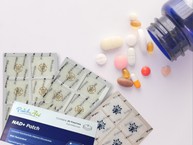Can taking a fat supplement really be healthy? When you’re talking about omega-3 fats, the answer is that it may have many benefits.* Omega-3 fats may not be essential vitamins or minerals, but they are essential for optimal health.*
Many people don’t get recommended amounts, but you can change that for yourself. You don’t even have to take fish oil capsules or cod liver oil that can give you a fishy burp or aftertaste. Instead, PatchAid Omega-3 Vitamin Patches have a variety of omega-3 fatty acids, plus related ingredients, to support the benefits of omega-3s.* Here’s what you should know about the benefits of omega-3s and how a PatchAid Omega-3 Vitamin Patch can help. As always, it’s a good idea to talk to your healthcare provider before using any dietary or nutritional supplement.
Benefits of Omega-3 Fats
A good deal of research has looked into the roles of omega-3 fats and how they can support health. Here are some of the likely benefits of having enough omega-3 fats.*
Support heart health. Omega-3 fats are linked to lower triglycerides, reduced plaque development in the arteries, and even lower risk for heart attack.
Promote normal blood pressure. High blood pressure affects half of adults, and omega-3’s are linked to a higher chance of having a normal blood pressure. Stroke risk may also be lower.
Support normal mood. Low intakes of omega-3 fats are linked to higher risk for depression and other mood disorders. Anxiety appears to be less severe for people who have higher omega-3 intakes.
Promote normal bone mineral density. There appears to be a relationship between omega-3 fats and bone mineral density. Researchers don’t yet know exactly how it might happen, but some evidence suggests that omega-3 fats promote the integration of calcium into bone mineral.
Promote normal brain development. Many prenatal vitamins include omega-3 fats, and there’s a good reason: a developing brain needs them. Omega-3 fats during pregnancy and after birth are linked to normal cognitive development.
Support visual health. Omega-3 deficiency may be related to age-related macular degeneration, which is a frequent cause of impaired vision during aging. Developing eyes also need omega-3’s to be healthy.
Support normal immune function. Omega-3 fats are necessary for a healthy immune system. They are anti-inflammatory, which is useful for keeping things in order and reducing infections. It also appears that omega-3’s are needed for lowering the risk for autoimmune conditions, such as type 1 diabetes, in which your immune system attacks your body.
Support joint health. Healthy joints have cushioning so that you don’t feel pain when you move. When that cushioning wears down or becomes inflamed, you can develop arthritis, which can hurt. It’s possible that people who have higher amounts of omega-3’s in their bodies can have less pain from arthritis, but more research is needed.
The PatchAid Omega-3 Vitamin Patch has 1,300 mg of total omega-3’s.
Food Sources of Omega-3 Fats
When it comes to food sources of omega-3 fats, it’s important to understand that there are different types. Plant-based foods have a type of omega-3 fat called alpha-linolenic acid, or ALA. In fact, ALA is an essential nutrient.
Seafood has a class of omega-3 fats called long-chain omega-3s. They include docosahexaenoic acid, or DHA, and eicosapentaenoic acid, or EPA. Your body can make a small amount of EPA and DHA from ALA, but not much.
These are some sources of ALA.
- Walnuts
- Canola oil
- Tofu
- Flaxseed and flaxseed oil
You can get EPA and DHA from seafood, including fish and shellfish. Fatty fish are the best sources, and these are some examples.
- Salmon
- Tuna
- Mackerel
- Herring
- Trout
- Sardines
- Anchovies
Why Take an Omega-3 Supplement?
With all these food sources of omega-3s, why should you use omega-3 vitamin patches? Here are some reasons why some people may not be getting optimal amounts of omega-3 fats.
- You don’t eat fish, for many possible reasons. It could be because you follow a plant-based diet, you don’t like the taste, or you avoid fish because you worry about contaminants such as mercury.
- You don’t eat the recommended amount of fish, which is two 4-ounce servings weekly.
- You don’t regularly eat walnuts or flaxseed or you don’t use flaxseed and canola oil regularly.
Another reason to consider a supplement is if you are not sure if you eat enough omega-3s and you don’t want to worry about it.
Vitamin Patches for Omega-3’s
Omega-3 supplements come in many forms. Examples include capsules, soft gels, and oils. They can have drawbacks such as a fishy aftertaste or burps that taste fishy. They can also be hard to swallow or lead to digestive discomfort. Finally, many omega-3 oral supplements have only one type of omega-3, and not EPA, DHA,and ALA. A vitamin patch, such as the PatchAid Omega-3 Vitamin Patch, doesn’t have these concerns.
The PatchAid Omega-3 Vitamin Patch:
- Causes no difficulty with swallowing.
- Has no fishy aftertaste.
- Has EPA, ALA, and DHA.
- Does not have toxic levels of mercury.
- Includes astaxanthin, coenzyme Q10, and phosphatidylserine.
Sources of omega-3’s in the PatchAid Omega-3 Vitamin Patch include Antarctic krill oil and black currant seed oil.
The PatchAid Omega-3 Vitamin Patch comes in light brown and clear options. Just stick one on and leave it for up to 8 hours before removing it and repeating the next day.
Omega-3 fats are some of the world’s healthiest fats, and they have all kinds of likely health benefits.* Even though they’re in many foods, most people don’t get adequate amounts, and taking fish oil supplements can be unpleasant for some. That’s why a PatchAid Omega-3 Vitamin Patch may be a good choice for you. Just be sure to ask your healthcare provider before taking any dietary or nutritional supplement.
*The Food and Drug Administration has not evaluated these statements. PatchAid products are not intended to diagnose, treat, cure or prevent any disease. Anyone with a medical condition should seek the advice of a licensed medical practitioner. Individual results may vary.







